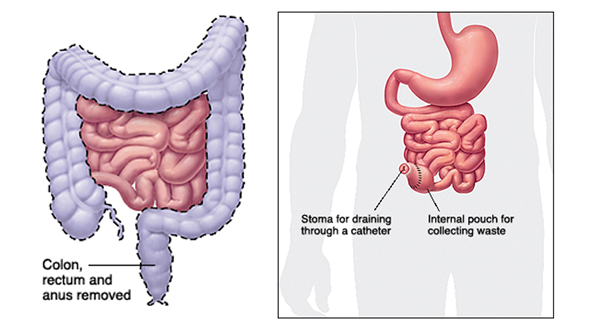85129
Having Bowel Surgery: Continent Ileostomy
This surgery is done to treat diseases of the digestive tract. It removes all of your large intestine. During the surgery, an opening (called a stoma) is created in your belly or abdomen.
When healed, waste collects in a pouch inside your body. It is then drained through a thin tube (catheter). A bandage covers the stoma when it is not in use.
There are two ways the surgery may be done:
- Open surgery. This is a traditional surgery. It is done through a large cut (incision).
- Laparoscopic surgery. This is a minimally invasive surgery. It is done through small incisions.
Your healthcare provider can discuss which option will be best for you.
|
Risks and complications
Bowel surgery has certain risks and possible complications. Your healthcare provider can discuss them with you. They may include:
· Infection
· Injury to nearby organs
· An anastomosis (pouch) that leaks
· Blood clots
· Risks related to anesthesia
· Complications at the stoma area such as bleeding, blockage, or a hernia
|
Getting ready for surgery
Follow any instructions about getting ready from your healthcare provider. Preparation may begin a few weeks before surgery and can include the following:
- If you smoke, try to quit.
- Tell your provider about any medicines you are taking. You may need to stop taking all or some of these before your surgery. This includes:
-
- Prescription medicines
- Aspirin and over-the-counter pain and fever medicines known as nonsteroidal anti-inflammatory drugs (NSAIDS).
- Blood-thinning medicines (anticoagulants)
- Street drugs
- Herbs, vitamins and other supplements
- If you drink alcohol, let your provider know how much you drink. This is especially important if you are a heavy drinker. Alcohol withdrawal can be life threatening, so be honest with your provider.
- If you will have a stoma, a specially trained healthcare provider will meet with you. This provider will be called an enterostomal therapy (ET) nurse or a wound, ostomy, and continence (WOC) nurse.
- This ostomy nurse will evaluate and help guide the placement of the stoma. However, the actual site the stoma is placed will be determined by the surgeon during the surgery based on what they find in the OR. The site may change but usually an ileostomy is usually placed in the right lower part of the belly.
- After the surgery, the ostomy nurse will see you and answer any questions you have. He or she will also teach you (and your family/significant others if you wish) about caring for the ostomy.
- Follow any directions you are given for taking medicine and for not eating or drinking before surgery. This includes any instructions for bowel prep.

The procedure
This surgery is done for people who do not want to have a pouch outside of their body to collect waste. It may be done after a permanent ileostomy.
- A part of the small intestine is reshaped to form a pouch that holds waste inside the body.
- The internal pouch is connected to an opening in the belly wall to let waste leave the body.